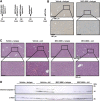IRE1 RNase controls CD95-mediated cell death
- PMID: 38383861
- PMCID: PMC11014915
- DOI: 10.1038/s44319-024-00095-9
IRE1 RNase controls CD95-mediated cell death
Abstract
Signalling by the Unfolded Protein Response (UPR) or by the Death Receptors (DR) are frequently activated towards pro-tumoral outputs in cancer. Herein, we demonstrate that the UPR sensor IRE1 controls the expression of the DR CD95/Fas, and its cell death-inducing ability. Both genetic and pharmacologic blunting of IRE1 activity increased CD95 expression and exacerbated CD95L-induced cell death in glioblastoma (GB) and Triple-Negative Breast Cancer (TNBC) cell lines. In accordance, CD95 mRNA was identified as a target of Regulated IRE1-Dependent Decay of RNA (RIDD). Whilst CD95 expression is elevated in TNBC and GB human tumours exhibiting low RIDD activity, it is surprisingly lower in XBP1s-low human tumour samples. We show that IRE1 RNase inhibition limited CD95 expression and reduced CD95-mediated hepatic toxicity in mice. In addition, overexpression of XBP1s increased CD95 expression and sensitized GB and TNBC cells to CD95L-induced cell death. Overall, these results demonstrate the tight IRE1-mediated control of CD95-dependent cell death in a dual manner through both RIDD and XBP1s, and they identify a novel link between IRE1 and CD95 signalling.
Keywords: CD95; Cell Death; ER Stress; IRE1; Unfolded Protein Response.
© 2024. The Author(s).
Conflict of interest statement
EC is a founder of Thabor Therapeutics. The authors do not declare any conflict of interest.
Figures










References
-
- Avril T, Vauleon E, Hamlat A, Saikali S, Etcheverry A, Delmas C, Diabira S, Mosser J, Quillien V. Human glioblastoma stem-like cells are more sensitive to allogeneic NK and T cell-mediated killing compared with serum-cultured glioblastoma cells. Brain Pathol. 2012;22:159–174. doi: 10.1111/j.1750-3639.2011.00515.x. - DOI - PMC - PubMed
MeSH terms
Substances
Grants and funding
- PDF20171206671/Fondation ARC pour la Recherche sur le Cancer (ARC)
- PJA20181207700/Fondation ARC pour la Recherche sur le Cancer (ARC)
- N/A/Fondation de France (Foundation of France)
- ITN-675448/EC | H2020 | PRIORITY 'Excellent science' | H2020 Marie Skłodowska-Curie Actions (MSCA)
- PLBIO 2018,2019/Institut National Du Cancer (INCa)
LinkOut - more resources
Full Text Sources
Medical
Research Materials
Miscellaneous

